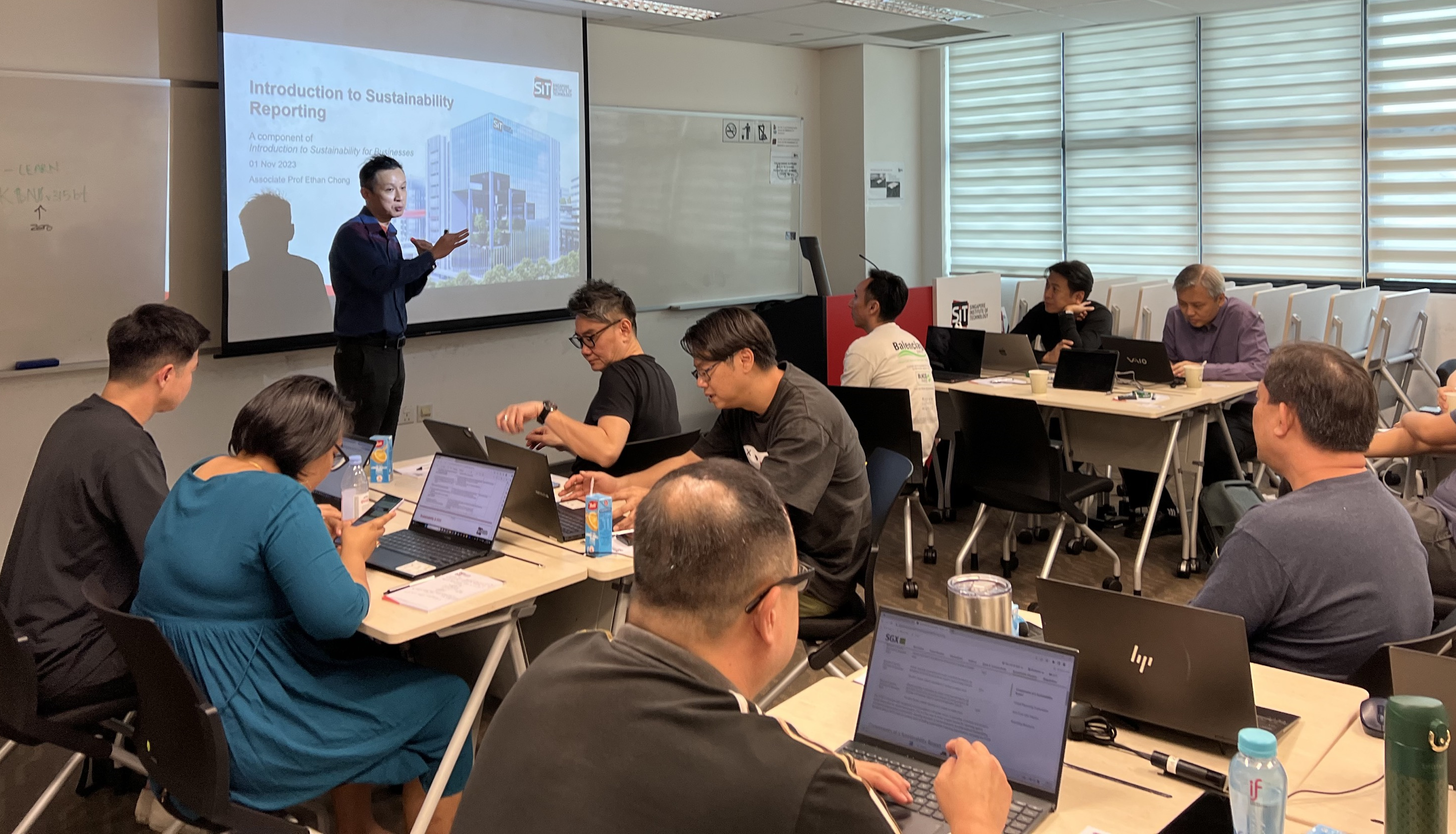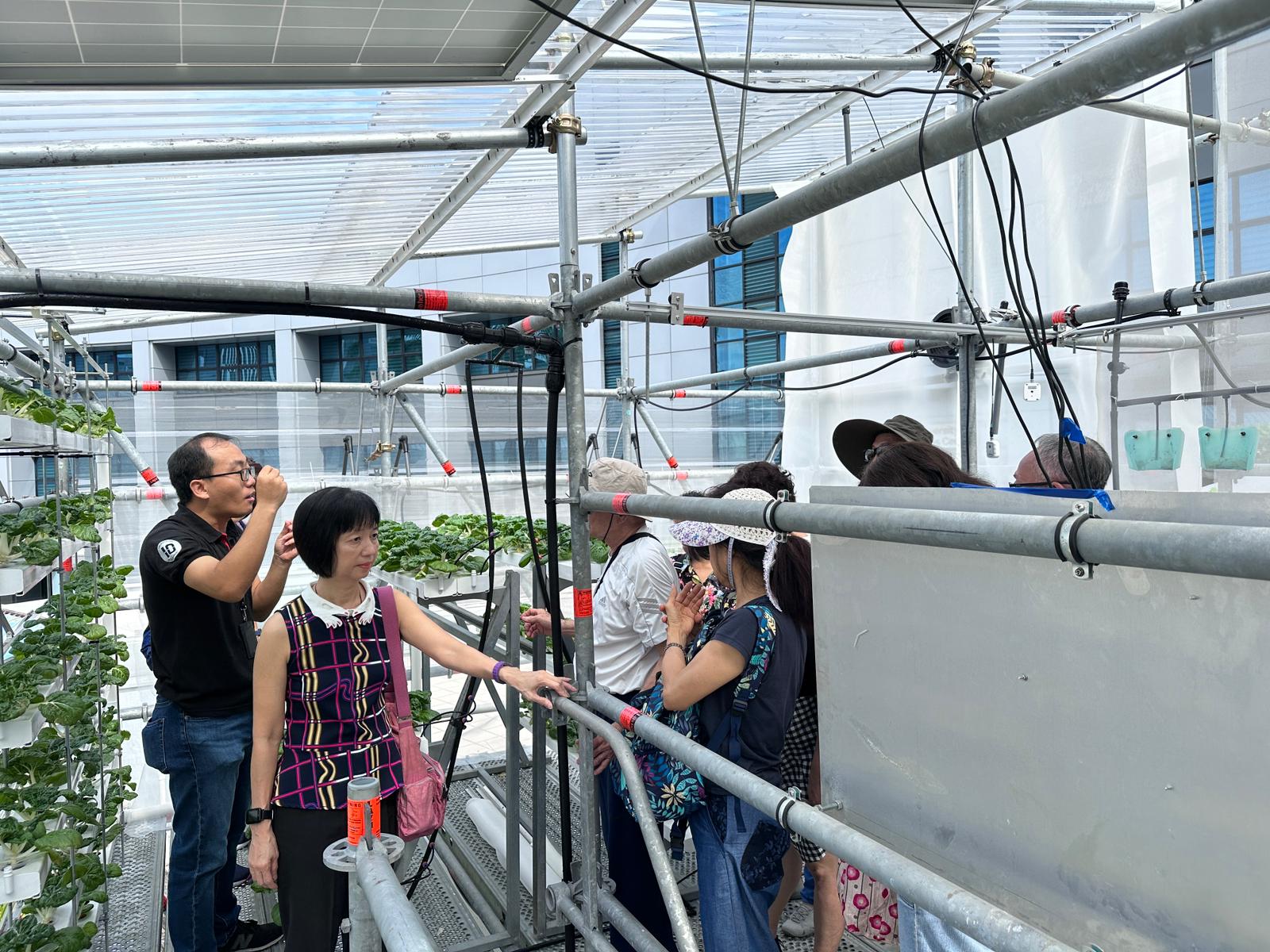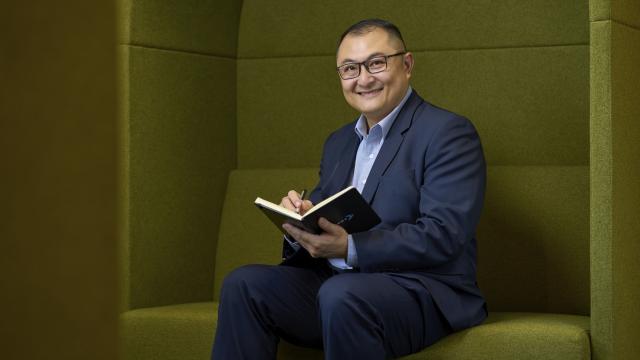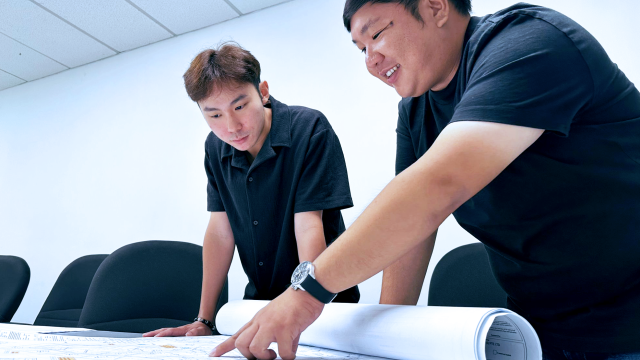Through an academic curriculum and R&D projects, the Singapore Institute of Technology (SIT) is equipping students, researchers and industry professionals with the knowledge, skillsets, and infrastructure to find solutions to the challenges of sustainable development. Associate Professor Ethan Chong, Head of Sustainability (Education & Research), Provost Office, Singapore Institute of Technology, explains.

Associate Professor Ethan Chong, Head of Sustainability for Education and Research at SIT, conducting a sustainability class for working professionals. (Photo: Ethan Chong)
The Singapore Engineer (TSE): Could you elaborate on the academic programmes offered by SIT that demonstrate its commitment to developing sustainability talent?
Associate Professor Ethan Chong (EC): With the growing urgency in finding solutions for sustainability issues, SIT is committed to developing a sustainability talent pipeline through its innovative and holistic approach to curriculum design and experiential learning.
In SIT, a baseline sustainability education is compulsory for all undergraduates of SIT and joint-degree programmes. A micro-module is designed to introduce students to key concepts of sustainability, including the definition, importance and multi-disciplinary nature of sustainable development. The module also serves to motivate young minds and initiate their actions. Students will get a chance to learn the key challenges in Singapore and benefit from industry insiders sharing their experiences and highlighting the needs of the industry.
Sci Dpl Glenn S Banaguas, renowned scientist, diplomat and one of the leading experts on the environment, climate change and disaster risks in Asia, sharing his experience on sustainability with SIT students. (Photo: Yeap Lay Huay)
Sustainability principles are also taught to and applied by students across disciplines. This is to foster a deeper understanding of the environmental, social and economic considerations in various domains. For example, SIT offers undergraduate and postgraduate degree programmes in Sustainable Built Environment and Electrical Power Engineering (EPE).
The former includes modules on renewable energy for building technologies and their applications, as well as building energy simulations and assessments. The latter covers areas such as renewable energy systems, smart grids, transportation electrification, industry automation and applications. The programmes are designed to equip students with the knowledge and skills needed to design and implement sustainable solutions.
At the undergraduate level, for students who want to deepen their knowledge in sustainability, SIT offers a Minor in Environmental Sustainability (MES) for a range of programmes. The Minor includes discipline-specific modules as well as sustainability core modules which cover a variety of topics such as life cycle assessment, sustainability reporting and the circular economy.
These core modules impart contents that are horizontally applicable to all sectors, providing learners with the fundamentals to address different domain-specific sustainability challenges. Students will go through deeper learning through applying their acquired sustainability knowledge and skillsets in a project module specially curated with the industry. In addition, students taking the MES will be given opportunities to participate in sustainability activities such as volunteering for campaigns.
TSE: Do students have opportunities to gain exposure to actual industry challenges?
EC: SIT works with industry partners such as ENGIE and Singapore Power (SP) to train sustainability talent. For instance, the District Cooling System (DCS) within SIT’s new Punggol Campus, which will provide chilled water for air-conditioning throughout the campus while reducing the carbon footprint, is designed and built by ENGIE. The DCS facility will be a teaching and training ground for students to learn about DCS and aspects of maintenance and energy efficiency in real-world conditions.
Through SIT’s collaboration with SP, the EPE faculty will be training students on smart grid technologies by leveraging the Multi-Energy Microgrid (MEMG). As a result, students undergoing Pre-Employment Training (PET) or Continuing Education Training (CET) can pick up much-needed skills such as data-driven optimisation, DCS decarbonisation and predictive maintenance learning, and conceptualisation of distributed energy systems.
TSE: How is SIT assisting industry professionals to keep abreast of new developments in the area of sustainability?
EC: SIT offers upskilling opportunities to empower professionals who are keen to explore the latest sustainability developments, best practices and technologies in their specific areas (such as Energy Efficiency Design, Audit and Analysis, Energy Sustainability, Maritime Decarbonisation etc) and horizontal capabilities such as sustainability reporting.
For instance, we have the Energy Efficiency Upskilling programme covering effective energy management and sustainability practices, which are critical for industrial organisations to reduce operation costs, comply with regulatory requirements and mitigate environmental impact to meet global energy sustainability and environmental challenges. Some of the key skills that would be gained via the course include the ability to identify energy-saving opportunities and set targets.
We also run a course titled ‘Introduction to Sustainability for Businesses’. This course, which is developed in collaboration with ASME (Association of Small & Medium Enterprises), will address key questions and guide learners on actions for positive impacts on the environment and their business. The application-oriented course brings participants through a process of identifying potential risks and opportunities that come with their company’s transition to the green economy.
TSE: Will SIT be introducing new academic programmes relating to sustainability?
EC: SIT is launching an Agritech and Aquaculture Specialisation, under the BEng (Hons) in Sustainable Built Environment (SBE) programme in Academic Year 2024. This is in anticipation of the transformation in the agri-food sector and the growing global demand for green talent. The new specialisation will cover a wide range of topics, including Agritech systems and Aquaculture economics. With this new specialisation, the SBE degree programme will have three distinct specialisation baskets – Integrated Facilities Management, Green Building Design, and Agritech and Aquaculture.

Associate Professor An Hui, Programme Leader for the SBE degree programme (far left), shares about the setup of the Urban-Metabolic Farming-Module, a novel farming method that utilises unused spaces to grow vegetables, to visitors at SIT@Dover. (Photo: Lim Wei Jun)
SIT is also launching a new Specialist Certificate in Environmental Sustainability Measurement and Management programme, tailored for working professionals, to support the industry’s growing sustainability reporting and management needs. The inaugural intake for the Specialist Certificate starts in the Academic Year 2024. The course provides learners with a comprehensive understanding of sustainability, by presenting various approaches to managing and advancing sustainability. This includes circularity, adaptation, mitigation, financing and policymaking. Learners will develop skillsets in quantifying, articulating and managing environmental sustainability.
TSE: How will SIT’s upcoming Punggol campus serve as a living laboratory for sustainability research?
EC: Our students will gain exposure to the unique infrastructure of the Punggol campus, with its several innovative features, whilst also enabling government agencies, industry and our ‘SITizens’ to deploy and test-bed solutions, before scaling them up for national adoption.The DCS at SIT’s new campus, which will be designed and built by ENGIE, as mentioned earlier, will provide training for our PET and CET students to learn about DCS and introduce aspects of maintenance and energy efficiency, as well as opportunities for them to work on projects such as DCS digital twins.
A Passive Displacement Ventilation (PDV) system, an innovative cooling system that uses natural convection instead of mechanical fans, will be implemented in the SIT Punggol Campus. The PDV system was co-developed by a research team from SIT, in collaboration with Er. Neo Poh Hong from Shinhan Tech-Engineering Pte Ltd and Mr George Ng from MET Engineering Pte Ltd. It is estimated that the PDV system is able to lower energy consumption by 20% compared to traditional air-conditioning systems.
Further, the SIT Punggol Campus will be powered by the Internet of Things (IoT) and have an Integrated Building Management System (IBMS) that controls campus-wide systems such as lighting, lifts and security.
The IBMS is supported by a campus-wide network of over 20,000 sensors that provide real-time data on ambient temperature, light and human presence to the IBMS which will use it to optimise energy usage throughout the campus. This data will also offer opportunities for students and partners to develop and implement solutions to enhance campus experience and workspace efficiency.
Also, SIT has partnered with Singapore Power (SP) to build the first Multi-Energy Microgrid (MEMG) on campus in Southeast Asia, which will also be the largest private MEMG in Singapore. It can integrate electricity from the national grid, renewable sources and energy storage in a unified smart energy network, to support applied learning and applied research. The MEMG will have approximately 10,000 m2 of photovoltaic (PV) solar panels. These will provide more than 2000 MWh of electricity annually, meeting about 4% of the total energy needs of the campus.
TSE: What are some of the other sustainability-related research initiatives undertaken by SIT?
EC: SIT and the National Environment Agency (NEA) have launched the Energy Efficiency Technology Centre (EETC) at SIT to support local Small & Medium Enterprises (SMEs) in energy assessment and energy efficiency-related applied research projects, and in upskilling industry professionals in industrial energy efficiency.

From left, EETC team members Abid Ali, Nur Umairah Binte Omar and Professor Lock Kai Sang analysing data collected from an ultrasonic flowmeter. (Photo: Keng Photography/Tan Eng Keng)
SIT is also working with partners to explore the testing of EVs on the grid, including Vehicle-to-Grid (V2G) charging and the potential effects on EV batteries. This is in line with the government’s plans to electrify our transport system.
And with the objective of developing foods for the future, SIT and the Agency for Science, Technology and Research (A*STAR) have secured funding to create a first-in-Asia testbed platform for researching plant-based proteins.



